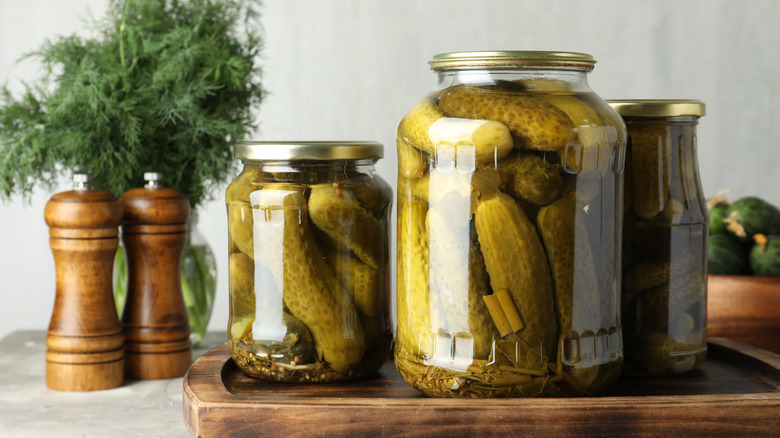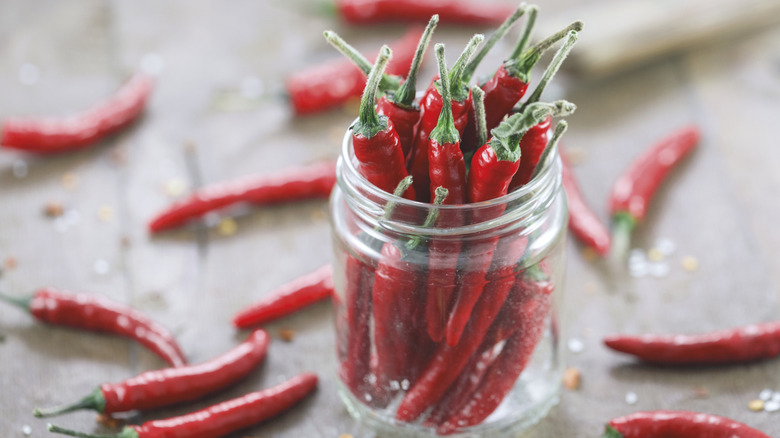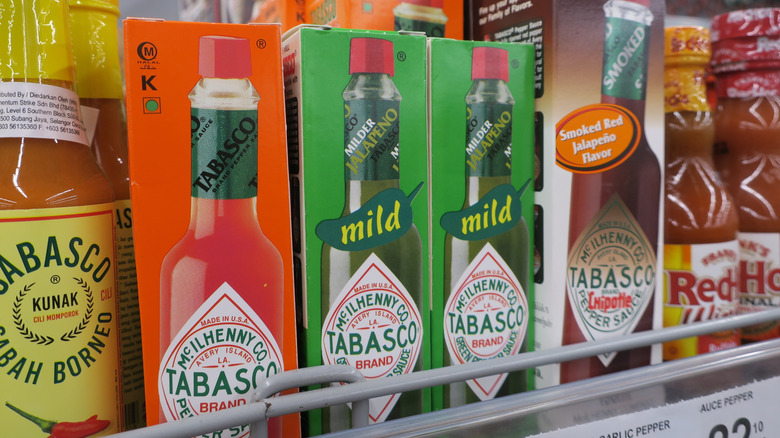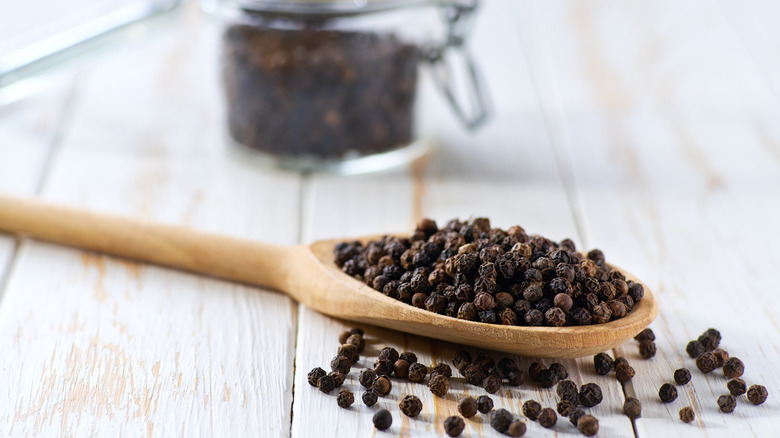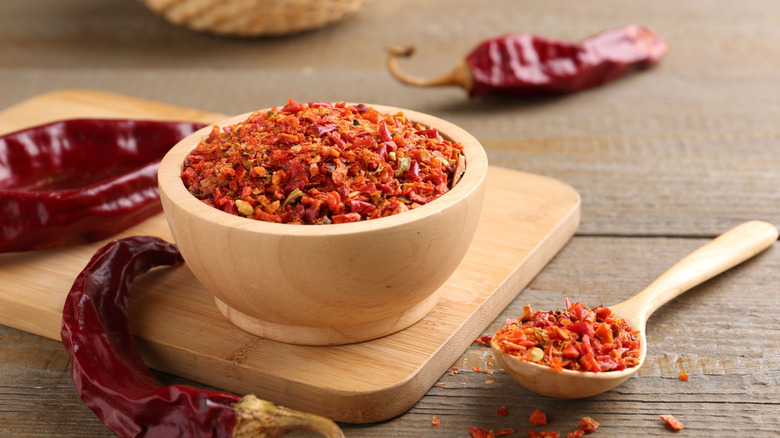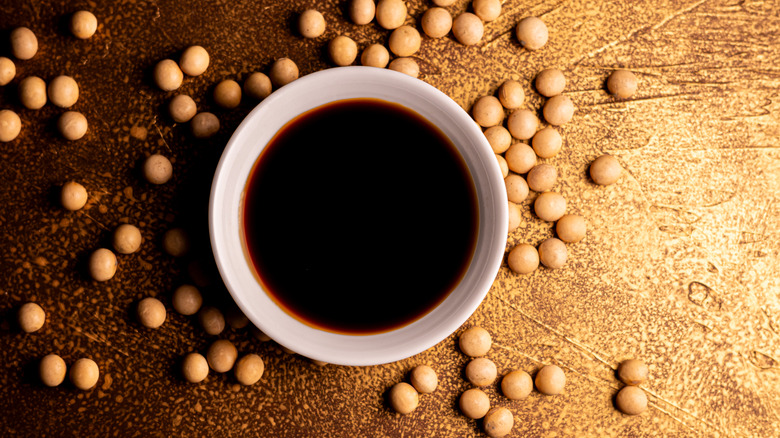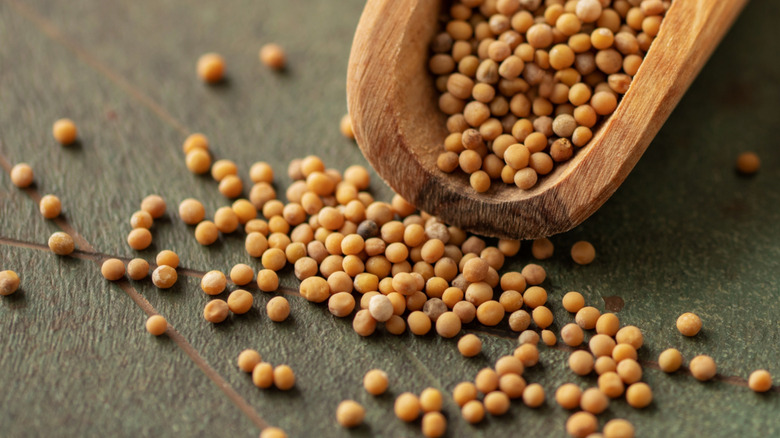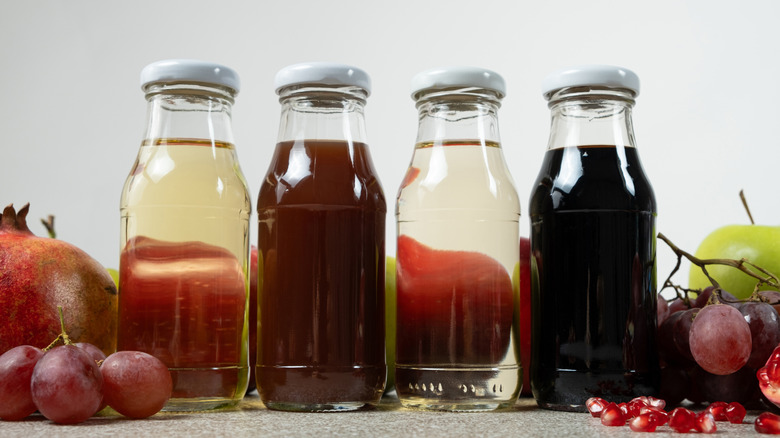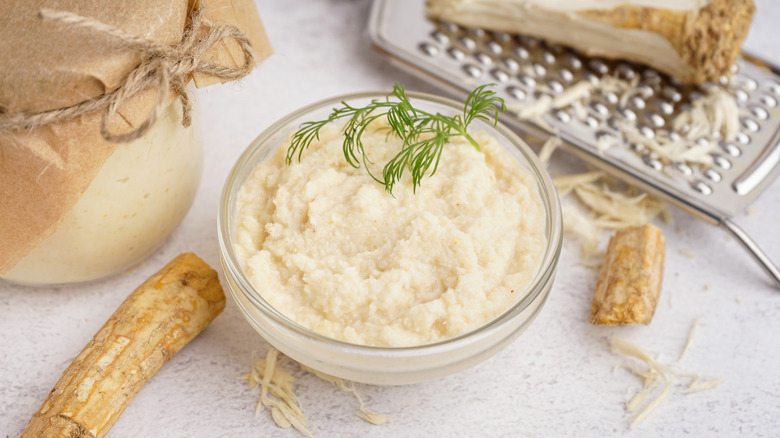12 Ingredients To Add More Flavor To Your Store-Bought Pickles
We may receive a commission on purchases made from links.
If you love pickles, you likely have jars and jars of them tucked away in your fridge for a mouth-puckering treat whenever you get a hankering. And though most of us pickle fans enjoy dills just the way they are, there are times when sampling something a little out of the ordinary can be just the right way to put a tasty spin on the day.
There are scores of recipes on the internet for how to make homemade pickles so we won't cover that here. Instead, we'd like to introduce you to an even easier way to enjoy delectable pickles by suggesting ingredients that can take the pickle flavor you love and kick it up a notch. From spices to veggies, there are tons of ways to amp your next pickle spear — no cooking needed. Coming up, we'll detail the steps you need to take to add delicious ingredients to your store-bought pickle jar, while also explaining what flavor you can expect from each and what fun ingredients you can combine to usher in dynamic flavor.
Get ready to relish the taste of pickle-y deliciousness as we uncover our curated list of 12 ingredients you can use to add more flavor to your store-bought pickles.
Peppers
Adding spicy peppers to store-bought pickles is a great way to impart flavorful heat to this tart treat. There are a variety of peppers that you could use, including habanero, banana peppers, or jalapeño peppers. To get it done, simply slice whatever peppers you wish to use and toss them in the jar, along with your store-bought pickles. You don't even need to slice your peppers if you don't want to; as long as they fit comfortably in the jar, you can feel free to toss 'em in whole.
Also, don't underestimate the power of hot pepper juice — dump out your pickle juice (don't worry, you can repurpose your pickle juice) before adding the liquid from canned or jarred peppers back into your pickle jar. Your pickles will soak up the flavor of the delicious juice yielding a fiery yet flavorful spin on an old favorite.
If you aren't exactly a fan of spicy ingredients, no need to feel left out. You could just as easily add bell peppers to your next jar of pickles to enjoy the perks of their robust flavor, minus the heat. To do it, slice or chop the peppers and add them to your pickle jar. Choose between options like red, green, yellow, or orange bell peppers, bearing in mind that red bell peppers will yield a sweeter taste while green bell peppers will be more pungent. Experiment with one or all pepper types to make your store-bought pickle pepper combination your own.
Tabasco sauce
Another option for infusing heat is the addition of hot sauce to store-bought pickles. We recommend using Tabasco sauce, although there are a variety of hot sauces you could use, including Cholula Hot Sauce that's found in stores and on Amazon, which is amazing for imparting spicy Latin flavor to store-bought pickles.
Once you've narrowed down the type of hot sauce you intend to use, it's time to kick up the heat. How much hot sauce you add will depend on how hot you want your pickles — as with most ingredients on this list, you have full control over how much or how little hot sauce you use. If you really enjoy the flavor of hot sauce and want to make a bold statement in terms of heat, try draining the pickle juice (remember not to waste it — there are plenty of clever uses for leftover pickle juice) and replacing all of it with hot sauce and sugar. You'll need to be a fan of spice for this one, but it's a plausible pickle-flavoring method when you want to bask your taste buds in flavorful heat.
Black peppercorns
Black peppercorns might seem like a bold addition if you're not accustomed to using them, but they add a great flavor boost to store-bought pickles. Black peppercorns are the "whole" version of ground black pepper, meaning you can expect that adding black peppercorns to your pickle jar will give it punchy flavor. Still, though larger in size, black peppercorns won't impart the spicy potency you might think it will, especially when compared to its finely grounded relative.
Contrary to what you might think, ground black pepper gives your pickles a sharper kick than whole peppercorns. When whole peppercorns are added to store-bought pickles, they produce a more subtle fruity spice that you may find more enjoyable. Choose from not only black peppercorns but pink, green, and white peppercorns as well, noting that each will produce a slightly different flavor.
As for whether buying whole peppercorns rather than ground pepper to add to your pickle jar will provide the best flavor, well, that one's up to you. Aside from adding a full-bodied peppery flavor, your pickles will likely pick up more of the pepper when removed from the jar, meaning whatever you use your pickles in will end up also heavily essenced with the taste of black pepper. If that sounds good to you, go ahead and try it — otherwise, it might be to stick to whole peppercorn varieties for a more subtle flavor.
Red pepper flakes (or cayenne)
We've covered using various types of peppers to add more flavor to your store-bought pickles, but if you don't have peppers on hand, there are still plenty of viable ways to add delectable spice. Simply grab a bottle of dried red pepper flakes and sprinkle away. Red pepper flakes are a fantastic ingredient for adding adjustable heat to your pickles without needing to dice, chop, or slice anything.
To use red pepper flakes to upgrade your pickles, add them to your pickle jar and allow it to sit, keeping in mind that the longer your pickles sit with the red pepper flakes, the spicier your pickles will taste. Don't have red pepper flakes on hand? No problem. Ground cayenne works, too, but like ground black pepper, it packs more punch than red pepper flakes. Add it carefully, bearing in mind that whatever you pair your spicy pickles with (they work great as an ingredient for crunchy tuna salad, by the way) will get a spicy kick, too.
Some types of garlic
If you're a lover of all things garlic, you undoubtedly love flavoring store-bought pickles with it. Adding garlic powder to a jar of pickles will grace them with garlicky flavor, and, as always, that garlic flavor will accent whatever sandwich or entrée you choose to use them in (we suggest Alton Brown's roasted turkey Cuban sandwich). To add garlic powder, try starting with ½ teaspoon per jar and adjusting the amount according to preference. Of course, you can mix up the flavor by throwing in some of the other ingredients mentioned as well, including black peppercorns, red pepper flakes, and more. Just be sure not to add too many ingredients. Using too many of the aforementioned flavorful additions can cause flavors to muddle, making it difficult for taste buds to discern individual flavors.
And while we're on the topic of using garlic as an ingredient to upgrade store-bought pickles, we should warn you that there is some risk associated with adding fresh garlic cloves to jarred pickles. Since garlic is a low-acid vegetable, canning them can lead to botulism. And while there are many out there who recommend adding this flavorful ingredient to jarred store-bought pickles, we would advise opting for garlic powder instead —just to err on the safe side. If you're looking for a great brand to try with loads of potent flavor, give Spice Classic Granulated Garlic a go and see what you think!
Soy sauce
If you love the taste of Asian fare, adding soy sauce to your pickles might prove right up your alley. We've scouted people in the Reddit pickling community whipping up Japanese soy pickles from scratch, but you could totally douse a little soy sauce in your next pickle jar (along with complementary flavors) to recreate the taste of soy pickles the lazier way.
Pick your favorite brands of soy sauce (Kikkoman Soy Sauce will work well here) and put a few splashes of it in your jar of store-bought pickles. Along with this ingredient, consider adding ground ginger and garlic powder; you can even go for a few sprinkles of red pepper flakes for an additional punch. Be sure also to add a little sugar to the mix, as doing so can help balance the salty and umami characteristics of the soy sauce added. Feel free to experiment with flavors that pair well with your soy sauce infusion. Black peppercorns, fresh peppers, and onions (more on adding those to jarred pickles later) would also make wonderful ways to add more even more scrumptious flavor.
Worcestershire sauce
Worcestershire sauce might seem like an odd ingredient to add to pickles, but the taste of this condiment can offer pickles a flavorful umami undertone that accentuates them beautifully. Like with soy sauce, the amount of Worcestershire sauce you add to your pickles will be up to you. Since the flavor is strong, we'd recommend going light and maybe sticking with only a dash or two, especially if your can of pickles is on the smaller side. And though Worcestershire sauce is already kissed with a touch of sweet flavor, if the taste of the Worcestershire sauce becomes too pungent in your jar of pickles, especially over time, you might consider adding a bit of sugar to help balance the flavor.
Keep in mind also that Worcestershire sauce is yet another one of those ingredients that plays well with other ingredients when it comes flavoring store-bought pickles. Try adding peppercorns and bell peppers, along with a dash of garlic to start. The possibilities are endless; just be sure to stay light-handed with all your additions, especially the ones that pack robust flavor.
Sugar
We've mentioned this a couple of times already, but adding sugar can do wonders for store-bought pickles. Sugar works to counteract the tangy flavor that accompanies most pickle varieties to give them a sweeter, more subdued flavor instead. This is particularly helpful if you happen to cop a jar of pickles that taste particularly sour. Adding sugar to pickles also helps when tossing other ingredients in your jar, like hot sauce, peppers, soy sauce, or Worcestershire sauce. Its sweetness often works to quell these otherwise potent additions.
Not a fan of table sugar? No problem. Try adding pure maple syrup to the mix (there are plenty of delicious store-bought maple syrup varieties available, with our favorite being Anderson's Pure Maple Syrup) or sprinkling in a bit of Splenda if you're looking for sugar-free options. Either sweetener will work in a manner similar to table sugar, though each will impart its own unique flavor to pickles as well.
Of course, all the previous suggestions have been given upon the assumption that you actually like sweeter flavors. If sour yet salty lip-puckering pickles are your thing, then skipping the sugar is totally a-okay.
Warming spices
If you're used to making homemade pickles and love a good pickling spice, you know the joy of using warming spices when for infusing flavor. There are a variety of spices you could use here, but keep in mind that most pack quite a punch in the flavor department. Options like cinnamon, cloves, allspice, coriander, and more are all superb add-ins, though we recommend you stick to their berried or seed form (we're specifically talking about the cloves, allspice, and coriander) rather than chucking in these ingredients already powdered. As you might guess, the reason for this is that using the ground form of many of these spices might prove a bit strong — maybe a little too strong in most cases. Instead, choose your combination of warming spices, throw them together, and sprinkle them into your pickle jar, bearing in mind that the strength of the flavor will increase as it sits.
Don't like cinnamon or a certain spice? Don't use it! Though there are many spice blends for pickling out there, the beauty of making your own blend for store-bought pickles is that you're in control.
Mustard seed
Mustard seeds are often featured in pickle brine, and for good reason; the lure of these seeds lies in their flavor. Like peppercorns, mustard seeds lend pickles a pungent yet unique flavor with just the right amount of spice. There are several mustard seed varieties you could choose from, including brown, yellow, black, and even white mustard seeds. White mustard seeds tend to be the most subtle, while the black variety is the most robust.
So, just how much mustard seed will you need in your jar of pickles? That'll depend on the size of the jar, but in general, you may wish to aim for around 1 teaspoon, depending on how strong you want the flavor and what variety of mustard seed you are using. Like with most ingredients, you'll need to experiment to find the correct amount of mustard seeds to add to achieve your desired flavor. Whichever amount you choose, know that scattering mustard seeds into a jar of pickles is almost always a good idea.
Sundry types of vinegar
Yes, pickles are already quite sour as is, but the fact is that you can change the flavor profile of store-bought pickles just by adding (more) vinegar. If you're starting with a full jar of store-bought pickles, you'll likely need to dump a little of the pickle juice out to make room for extra vinegar. Select the vinegar of your choice and add it in. After you add your vinegar, wait a couple of hours, and then give it a taste. If you like the flavor — great! If not, you can always add more vinegar.
There are many vinegar types out there to choose from, and while most will fit the bill, not all will yield the same results in terms of flavor. Using white distilled water (best used in small amounts) will yield a harsher taste while apple cider vinegar will infuse your store-bought pickle jar with mellow vibes. Red wine vinegar, balsamic vinegar, and rice wine vinegar are other plausible choices; which you should choose will ultimately depend on what you're craving for the day!
Horseradish
Adding horseradish to pickles will guarantee a spicy outcome, and if you're a lover of heat, this is one ingredient you've got to try. Horseradish is a root vegetable that gets its spice from a compound called isothiocyanates and is in the same family as mustard. It can be purchased fresh or prepared, as is the case with this Beaver Deli Horseradish Sauce. To enjoy horseradish in pickles, either grind fresh horseradish in a blender or food processor with water or consider adding store-bought horseradish directly to the pickle brine to make things easier. Start with about a tablespoon of horseradish, then kick it up from there, if you're feeling brave.
Of course, if you find that a single tablespoon of horseradish is too much, you can always adjust the amount you add next time until you find the amount that best suits your taste buds. Remember that because horseradish carries with it an extremely strong flavor, you may want to pair it with a sweetener, such as maple syrup or sugar, to take the edge off. Combine this with apple cider vinegar, a smidge of garlic powder, or a variety of other flavor combinations to add a spicy twist to your next jar of drab pickles.
